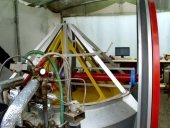
















Nick Raaum wrote:Also without getting into the specifics of moedlling what the efficiencies will be I'd like to emphasize that efficiency is not the main metric to consider in designing these systems, overall cost per kwhr is. A simple low tech system operating at 5% efficiency may end up being superior in terms of providing people with a resilient and autonomous energy system to the more efficienct and complex PV or biomass system.
Buy Our Book! Food Web: Concept - Raising Food the Right Way. Learn make more food with less inputs
Off Grid Homesteading - latest updates and projects from our off grid homestead




Nick Raaum wrote:Marcos,
I agree PV is most cost effective at present. However i think it'd be unfortunate if CHP solar thermal options such as this are not explored as distributed solar alternatives. Pv tech will remain wedded to the industrial complex for the for-seeable future, and is both less resilient and autonomous than a simple heat engine could end up being.
IMO what is needed are several open source crowd funded experiments to flush out the feasibility of attractive options like this one. These engines are operating in a completely different manner than there energy dense IC cousins and need to be designed to cost effectively around the low operating temps and pressures. Piston and cylinder design may not be optimal at all, perhaps a "bellows" style piston would prove more cost effective given the low pressures and high volumes.
As far as efficiency goes you are of course right electrical efficiencies will be low at those temperatures, but you do have a system producing heat which minimizes those losses. Also without getting into the specifics of moedlling what the efficiencies will be I'd like to emphasize that efficiency is not the main metric to consider in designing these systems, overall cost per kwhr is. A simple low tech system operating at 5% efficiency may end up being superior in terms of providing people with a resilient and autonomous energy system to the more efficienct and complex PV or biomass system.








Nick Raaum wrote:The only problem with biomass is that overall cycle efficiencies are bottlenecked by the photosynthetic efficiency of the plants, which is probably around .1-.2% efficient. So its a fine solution for using woody wastes or sensible energy biomass crops (populars ect), but it'll never really scale anywhere near the orders we'd need in the long run. I tend to think in the long run biomass energy is for transport only and one way or another we'll have to use solar for electrical production. That is likely much too long range thinking though to be practical and if you are just looking to unplug now I'd agree with your approach. Still the optimist and idealist in me wants to figure out whether a low tech solar solution is feasible now.
I do agree the organic rankine cycle has potential and would yield higher efficiencies than an a brayton cycle at the same temps. Yet I want something simpler and easier to operate and replicate.

|
Where all the women are strong, all the men are good looking and all the tiny ads are above average:
montana community seeking 20 people who are gardeners or want to be gardeners
https://permies.com/t/359868/montana-community-seeking-people-gardeners
|






